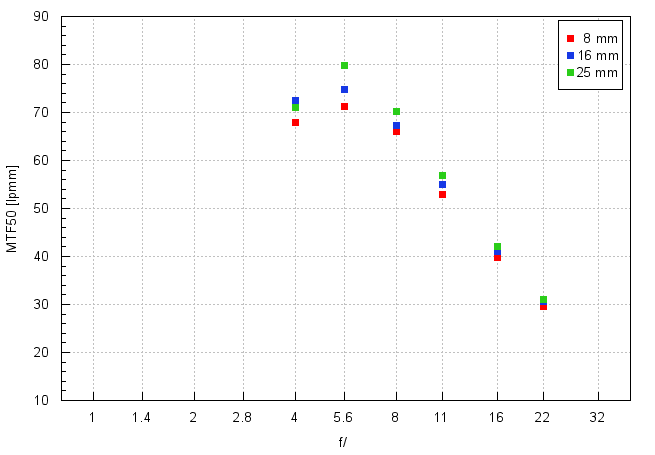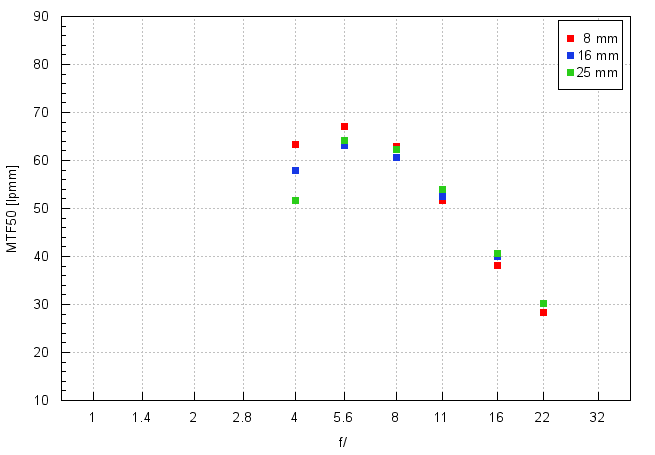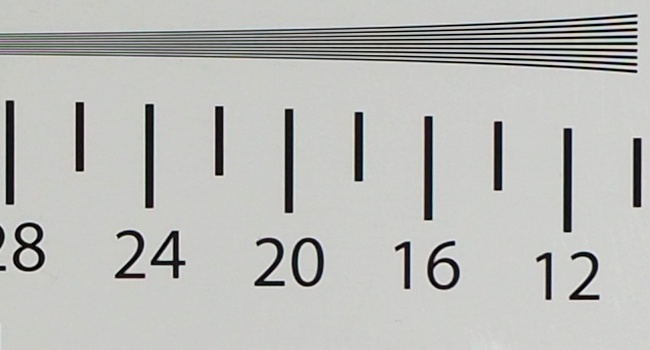Olympus M.Zuiko Digital ED 8-25 mm f/4 PRO
4. Image resolution
Let's check how the tested lens compares – its results in the frame centre at 8, 16, and 25 mm presents a graph below.

Please Support UsIf you enjoy our reviews and articles, and you want us to continue our work please, support our website by donating through PayPal. The funds are going to be used for paying our editorial team, renting servers, and equipping our testing studio; only that way we will be able to continue providing you interesting content for free. |
- - - - - - - - - - - - - - - - - - - - - - - - - - - - - - - - - - - - - - - - - - - - - - - -
When I test the resolution of different Micro 4/3 system lenses as fast as f/4.0-5.6 I always wonder what kind of a challenge it is for the optics constructors. After all, with such aperture values, diffraction already comes into play and, for the same reasons, resolution records in that system along with the highest values, can be achieved near f/2.8.
As you can imagine the task of a lens with an f/4.0 maximum relative aperture is really difficult. There is no room for mistakes that could potentially decrease MTFs in a 1-2 EV range from the maximum relative aperture; on stopping down the lens simply won't be able to spread wings. In this case by f/8.0, so on stopping down the aperture by 2 EV in order to limit significantly the influence of optical aberrations, available MTFs reach 70 lpmm, being far lower than the record level of almost 100 lpmm we set at the beginning of this chapter.
As you see these 70 lpmm will be a good reference level. If the lens is able to exceed it, it means the constructors have handled their task pretty well. Taking it all into account the results of the Olympus 8-25 mm in the frame centre look really well. By f/5.6 all focal lengths distinctly exceed 70 lpmm and at the maximum relative aperture they also keep close to that value, with an exception of 8 mm which result is slightly lower. If you add to that a more or less even performance across the focal range the overall image is positive indeed.
Still, there is a fly in this otherwise excellent ointment. The Olympus 12-45 mm f/4.0, so a lens equally fast, up from the maximum relative aperture was able to exceed even 80 lpmm. It proves the performance of the tested lens is good but it could have been even better. Of course in case of the 8-25 mm model optics specialists had to correct a wider range of angles of view, always an obstacle that raises the bar significantly.
Now let's check the performance on the edge of the frame – a graph below presents the results of our test.

From f/5.6 onwards you observe a very even performance at all focal length; what's more, the lens keeps a very good resolution level, exceeding 60 lpmm. It's worth adding that the 8 mm focal length fares the best at the maximum relative aperture; it's obvious it's been taken care of in a special way. The Olympus 8-25 mm doesn't have any weak points in this area and its results are just slightly weaker than these of its 12-45 mm system brother.
To sum up: after the test of the Olympus 12-45 mm f/4.0 our expectations concerning the 8-25 mm device were very high so we feel somewhat unsatisfied. On the other hand the new lens doesn't have any weak points and is able to produce sharp images across the frame and across the whole focal range – no mean feat with such parameters and something the lens should be praised for. In other words the Olympus M.Zuiko Digital ED 8-25 mm f/4 PRO performs exactly as it should; I think it won't let its users down.
At the end of this chapter, traditionally, we presents crops of our resolution testing chart taken from photos saved as JPEG files along with RAW files we used for the analysis above.
| Olympus E-M5 II, JPEG, 8 mm f/4.0 |
 |
| Olympus E-M5 II, JPEG, 25 mm, f/5.6 |
 |






